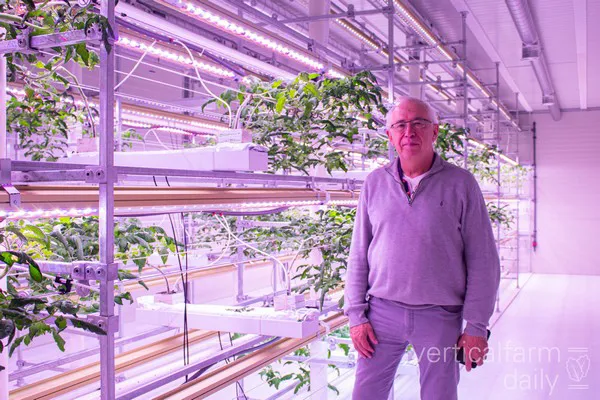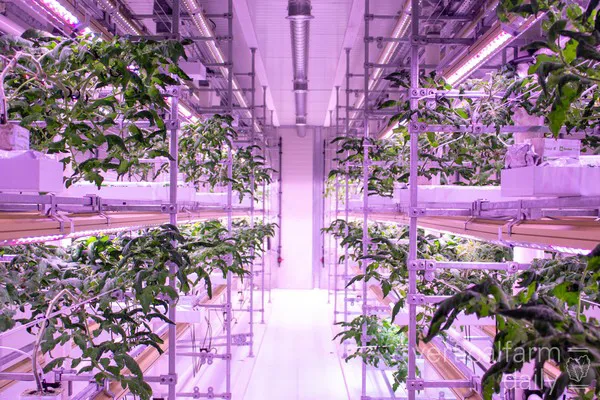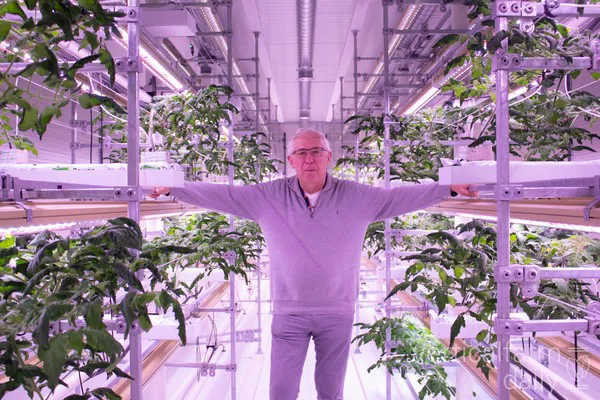"Our ongoing results show that we can obtain almost 2 to 3 times more KG cocktail tomatoes per m2 than in a greenhouse. A well-skilled greenhouse grower yields about 40kg per m2, whereas we harvest 110 kg per m2. We can supply systems that allow controlled tomato cultivation in two to up to five layers," explains Willem Jonkman, Founder and CEO of Hortigold.
In 2020, Willem conducted a tomato trial using a growing method that is often not seen in vertical farms. A six-week trial was held to research all key assets needed for horizontal cultivation in vertical farms. The reason behind growing horizontally instead of vertically is to save space and increase yield and put the plant central.
Starting off as a technology company that supplies PCA's (printed circuits boards) for robots, motherboards, and prints for devices such as cameras, security systems, and fiber optic network components, Hortigold lately has been using its broad knowledge in technology for the cultivation of fruiting crops. Willem Jonkman pictured in the trial facility
Willem Jonkman pictured in the trial facility
Blossoming tomato trials
"How is it possible that an electronics company can achieve these kinds of results in such a short time that horticulturists have never managed before? We started experimenting and using technology to create the perfect circumstance for a specific plant. This technology allows us to get data to optimize the plant process and create a cost-effective and sustainable system. By experimenting, we even gained knowledge about keeping bumblebees in a cell. You often see the animals become disoriented in an indoor farm, but we have adjusted the spectrum so that they can do their work quietly and have a pleasant living environment," Willem adds.
To create the new growing concept, Hortigold developed several sensors that, for example, measure the plant's water intake. They also are mapping leaf elements such as temperature and humidity, and the indoor environment can easily be steered into the required conditions. Moreover, the light, humidity, climate, and irrigation can be controlled to what the plant exactly needs at a time of day or specific growth stage.
"On top of that, we emit no CO2 and use just a fraction of what normally is done in horticulture. The use of carbon footprint indoors and outdoors are not used efficiently. We're using about 12kg of CO2 every three months, which is less than a regular greenhouse. We do the same with water use, the required nutrition, and energy for the lights. Through sensors and close monitoring, we not only can make indoor farming more affordable but also more sustainable."
"So far, we have grown the following varieties: Brioso, Tomagino, and the Yoom (Purple Umami tomato)." Now, the company is ready to launch trials on more varieties to offer a broad range of 'growth recipes' for various tomatoes and other (vine-)crops.  Pathway
Pathway
All you need: An empty greenhouse and add the 'New Horizon' growing concept
Although the complete growing solution is more expensive than a greenhouse, Willem claims that it only needs 60% of what a greenhouse would use and secondly is more durable. Thus eventually, the system comes out cheaper at the end of cultivation in terms of labor and resource efficiency.
Hortigold likes to call their solution the greenhouse of the future: the "New Horizon farm." Willem's vision is to place their "growing cells" inside a greenhouse as it is one of the cheapest zoning plans with low costs in comparison to other buildings.
The solution is available in modules of 8 cells, of which 8 are covering an area of about 1 hectare. "This allows growers to grow different varieties per module.
Besides the ability to grow multiple crops simultaneously, a synergy can be created between the modules. If four modules are placed for different varieties or crops, applying a 'collaboration' between the modules. Think of cooling down a growing room, moving excessive heat around where needed, and applying peak hours to reduce energy costs.
Adjustable efficient LED lights
Hortigold has developed highly adjustable LED lamps in-house. The drivers are placed outside the growing facility to mainly prevent extra heat from coming into the growing cells and save space. The LED lights can be controlled as a whole or as a section. "We can illuminate specific parts of the plant in a specific way so save up costs allowing us to be extremely energy efficient and ultimately create better and more food," Willem notes.
One of the benefits of growing horizontally, Willem notes, is that the tomatoes are just about 20 cm apart from each other and are shorter overall. This allows to illuminate all plants at their full width, 'which normally isn't done.'
Even fewer resources needed
According to Willem, their unique sensors not only help to take a 'plant central' approach, but it also helps to eliminate things you either don't want or need anymore. "We have been able to develop so many things based on the changes we've monitored. It's rather interesting to see a plant's response to these changes and how it adjusts to the environment. Take, for example, drinking sensors which enable to give the right amount of water as well as avoid wastewater which will become a real issue in the future. This is important because of water scarcity and also because the government forbids greenhouse growers to discharge recirculating water, which hence has to be recycled and cleaned. Due to its controlled environment and unique way of cleaning the air, there is also no need for pesticides resulting in clean products of very high quality."
Willem also sees potential for fully green energy greenhouses of this kind in the Middle East. "The glass roof can be fully displaced by solar panels so you produce your own energy, but you can also do that with a completely closed building."
"Our ambition is to enable the growing of more food at higher quality and do this in a more sustainable and cost-efficient way. We are targeting the Netherlands and UK in Europe to facilitate year-round production and the Middle East, South America and USA to address food security and production closer to the consumer. We're definitely open to collaborating with others," Willem concludes.
For more information:
Willem Jonkman, Founder and CEO
Hortigold
Cornwallstraat 6, 1976 BD
IJmuiden, the Netherlands![]()
Willem@hortigold.nl
